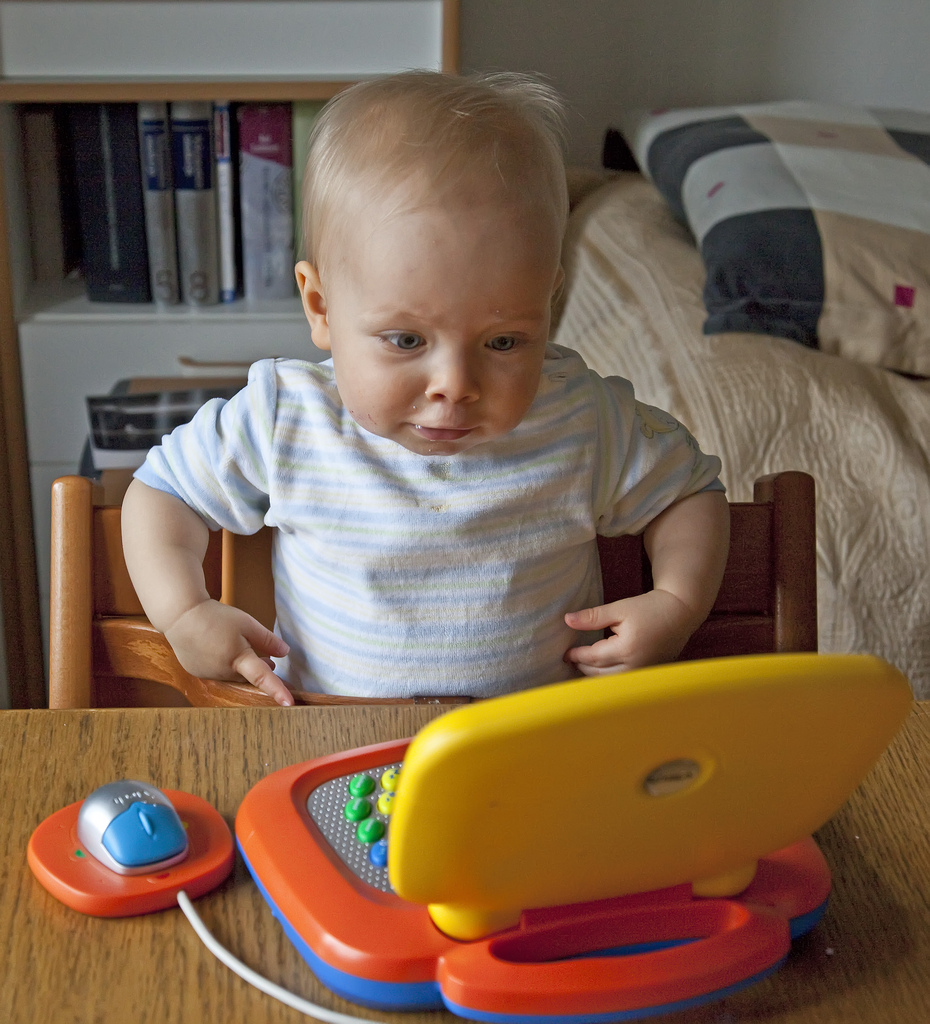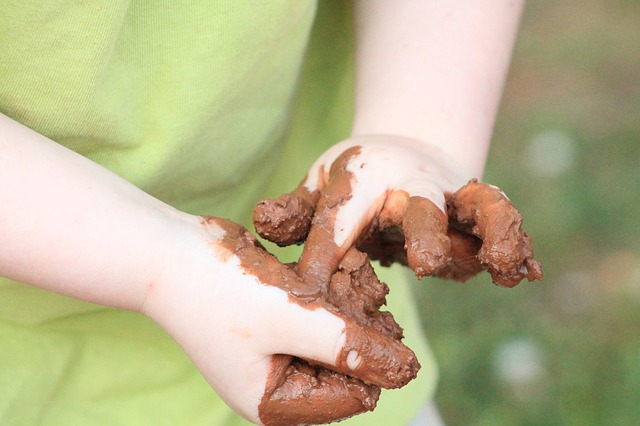Nothing beats unstructured outdoor play for improving handwriting skills.
However, there are a lot of other simple changes you can make in your child’s daily routine and indoor environment to promote the development of fine motor skills.
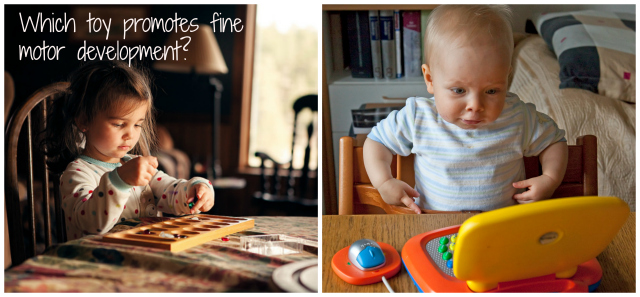
Toys and day to day life at home used to provide lots opportunities for children’s fine motor growth. But suddenly we are seeing a large number of children who are lacking adequate core, upper body and finger strength and dexterity to successfully pick up a pencil and write with ease.
Has home life really changed that much in the last 25 years to affect children’s fine motor development?
The transformation of children’s toys
If you really begin to examine the toys marketed to children today, you will notice a huge change has taken place.
Essentially, we’ve replaced toys that involved a lot of loose parts and manipulating with your hands with ones that require just a push of a button to make a sound or light up.
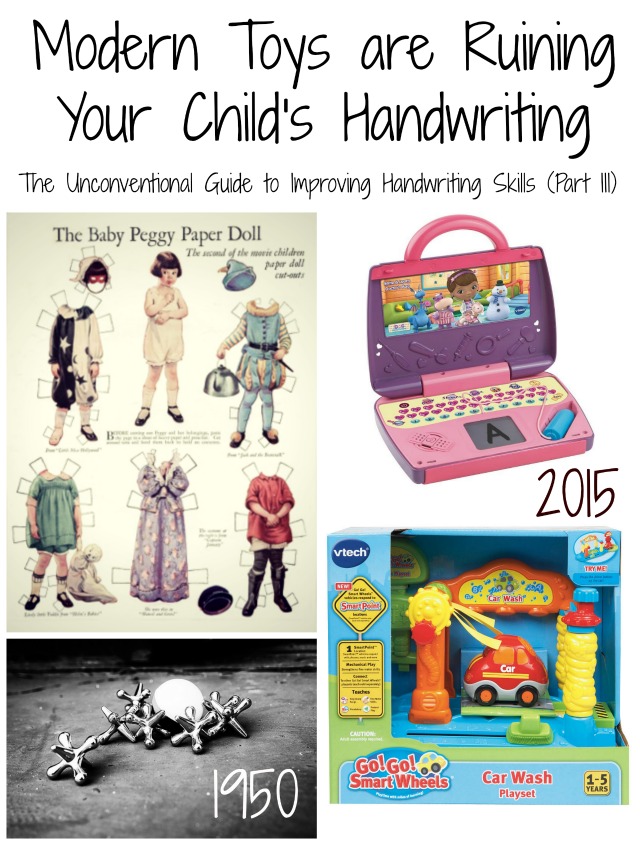
We have a ball in our house – given to us by a well-meaning family member – that rolls itself, makes animal noises when you press the creepy looking cartoon dog or cat and then yells at you when you stop interacting with it!
With a degree in Early Childhood Education, I’ve always been very adamant about the types of toys we have in our house for our daughter. I’ve always been against battery operated toys for the reason that they don’t require kids to problem solve, think creatively or use their imaginations.
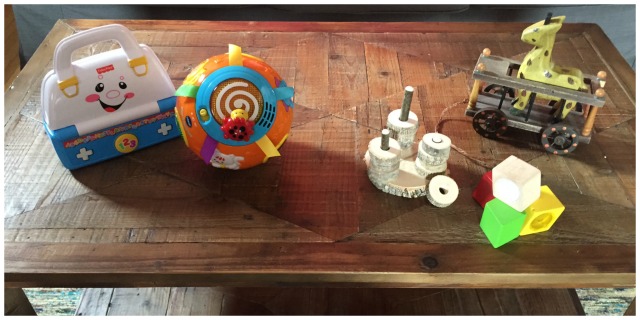
After speaking to some experts in pediatric occupational therapy, I learned that these modern electronic toys also deprive our children from practicing the necessary skills for fine motor and handwriting.
While of course toys are meant to entertain, the purpose of play in early childhood is to manipulate objects, perform experiments and examine the world in order to learn. While many toys today may keep a child busy, they may be doing nothing to actually enhance their development.
Rachel Coley, OT and founder of CanDo Kiddo, really enlightened me when I asked her if anything has changed in the last 25 years in regards to kids’ activities that develop fine motor skills.
Through the materials and toys we choose for our kids and the way they spend their time…
We over-emphasize the skills of pushing buttons with their thumbs and pointing, dragging and clicking with their index fingers.
Because there aren’t any more hours in the day than there use to be, these activities come at the expense of our kids learning to cut, glue, pinch, put together, pull apart, squeeze, twist, hammer and screw, lace, string and other important fine motor skills.
Think about the toys you played with as a child, or better yet your parents or grandparents.
Modern Convenience = Lazy Fingers
Just as life as gotten easier for mom with Click Connect car seats & strollers and Bumbo chairs at the expense of our babies’ gross motor skills development, modern convenience has also stripped our children of everyday fine motor skills practice.
We’ve made childhood really convenient and easy with velcro and slip on shoes, food that can be slurped from pouches and zippered lunch boxes. – Rachel Coley, OT, CanDo Kiddo
In addition, in our busy society we often do things for our children that they should be learning to do on their own.
I admit sometimes I am in a rush to get my daughter out the door and do a lot of things for her I shouldn’t like spoon her peas into her mouth (it’s faster and less mess) and avoid real cups (sippy cups don’t leave you bathed in milk).
However, when you aren’t pressed for time, slow down and let your kids try things on their own.
My daughter is very strong-willed so she often chooses to do things on her own even when I want to help – hence this adorable fiasco when she lost her shoe outside:
While this attempt was ultimately unsuccessful…
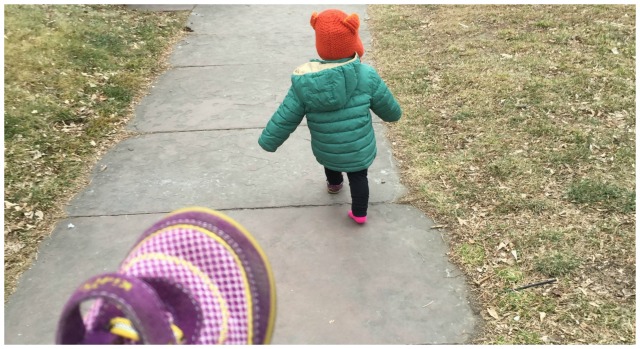
She has since improved since I let her have lots of practice – just not when we’re on a strict time table.
What are fine motor skills? Why are they so important?
Writing expectations for early elementary students have increased significantly over the last couple of decades. Some kindergartners have writing workshop for as long as an hour every day!
At the same time we are introducing more academic demands on children, we are replacing the activities and tools that naturally promote the development of fine motor skills.
Just understanding what fine motor skills are enables adults to seek out and promote experiences for children that will help develop these important muscles and skills.
The great news is that you don’t need to learn and prep a lot of fancy activities. Just by understanding the basics of fine motor skills, you can prioritize the materials in your house or classroom to facilitate this development in your kids.
Understanding the pincer grasp
The pincer grasp is the ability to pick up small objects using the thumb and forefinger. This develops by age one (and continues to mature) as babies move from a raking grasp with all fingers to picking up individual cheerios with just these two fingers.
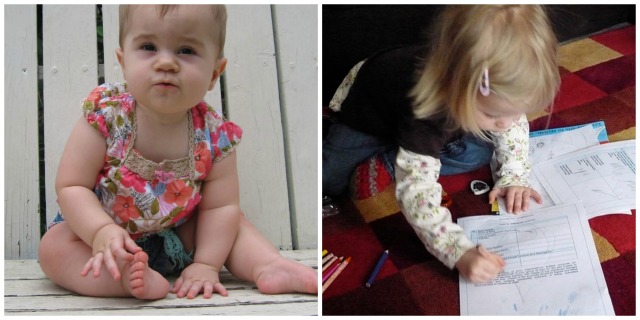
The pincer grasp is very important in handwriting. It enables children to hold a pencil correctly and develop a mature tripod grip around a pencil.
Seems simple, so why is it so important?
Children with nonfunctional pencil grips will not be able to keep up with the demand expected of them in school. They will begin to avoid writing tasks and their academics and confidence will suffer.
Here is what the development of a child’s pencil grip looks like:
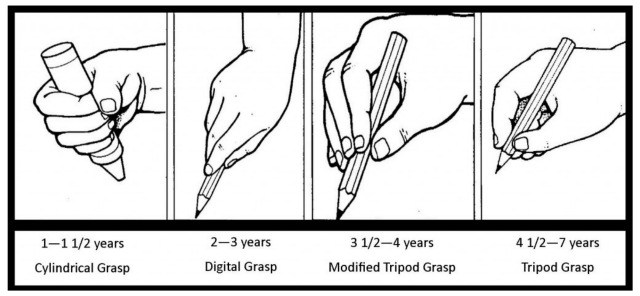
The importance of hand and arm muscles
Writing uses a lot of different muscles in the hand and wrist. In addition to developing a good pincer grasp, children need to make sure their hand and arm muscles are also strong.
Christie Kiley is a pediatric OT experienced in early intervention (birth to 3), clinic-based and school-based settings who runs the blog Mama OT.
While I knew that developing hand strength was important in improving handwriting skills, Christie explained to me just how complex and important these hand muscles are.
There are all sorts of small muscles in our hands that make up three main arches around our hands.
These arches work together to help our hands accurately form around objects as we hold and manipulate them, such as when we hold a ball, build with blocks, or brush our teeth or hair.
These palmar arches are also responsible for helping kids develop in-hand manipulation skills and dissociation of the two sides of the hand.
In order to properly develop these arches, Christie advocates for weight bearing activities on kids’ hands such as crawling through tunnels, doing crab walks down the hallway, yoga (downward dog) and gymnastics (handstands).

Strategies to improve handwriting skills
Just by editing a few things in your daily routine and having certain materials and toys on hand, you can help your child develop the necessary fine motor skills to improve handwriting.
The biggest things that parents can do to promote their kids’ fine motor skills is to evaluate the toys and materials in their homes and evaluate their family schedule.
Many parents are surprised to find that Occupational Therapists don’t have much specialized equipment for treating their children’s fine motor delays or handwriting difficulties.
What we have are toys and time being fully present with a child. – Rachel Coley, OT
Here are 5 tips for improving handwriting skills in your own home or classroom with lots of ideas for simple toys and materials to stock your house with!
1. Give time for independence in daily routines
It’s so easy today in our hectic lives to do things for our children that they could be learning to do themselves. Whether we don’t schedule in the time or are afraid of the mess – I’m guilty of both – encouraging your child’s independence has huge rewards.
Meal times, grooming and getting dressed are great opportunities to let kids take charge and strengthen those little hands and fingers!

During meal times kids should be working towards independence with:
- peeling fruit (oranges, bananas)
- pouring drinks
- using knives to cut food
- using knives to spread butter (or jam, cream cheese, PB) on bread
- opening & closing lunch containers, snack bags and water bottles
With babies, move beyond just purees and encourage self-feeding from the start. Toddlers should be using forks and spoons on their own and drinking from real cups.
After being inspired by Christie’s advice, Reagan successfully peeled her own clementine:

Toddlers definitely still need some help getting dressed but older children should be doing this independently with just a little support and adult encouragement.
While you may need to help out after to make sure the job is done thoroughly – have children participate in their own grooming.
Kids can:
- put on & take off socks and shoes
- do zippers, snaps and buttons
- learn to tie their shoes
- brush their hair
- squeeze their toothpaste
- begin to learn to floss
2. Help out around the house

Most moms know that having young kids at home – especially if they aren’t in school yet – makes it 10 times harder to get anything done around the house.
However, you can provide kids with lots of great fine motor experiences by having them help you out around the house.
Kids can help tear lettuce for salads, mash avocados for guacamole, grate cheese, scrub potatoes, mix thick batters and knead & roll dough when you’re working in the kitchen.
Last time my husband made a smoothie, my daughter help by separating the cilantro leaves from the stem – of course she threw the leaves in the sink and the stems in the blender, but she had a great time helping out!
While doing laundry, kids can help pull clothes out of the hamper, washer and dryer. The youngest kids can fold socks while older children can help with shirts and pants.
3. Buy the right toys
While most parents despise talking toys, now we have some real reasons to replace them in our homes – your child’s fine motor skills, handwriting and success in school depend on it.
Here are some simple guidelines to purchasing toys to promote fine motor skills:
- Avoid anything with batteries
- if it lights up, moves on its own or makes noise count it out
- Stick with natural materials
- it’s much harder to go wrong with toys made out of wood
- Look for toys with “loose parts”
- check Etsy or DIY – sometimes the best toys are not really “toys”
- Look to Reggio Emilia and Montessori schools for inspiration
Need some more ideas? Here are some examples of great toys to buy:
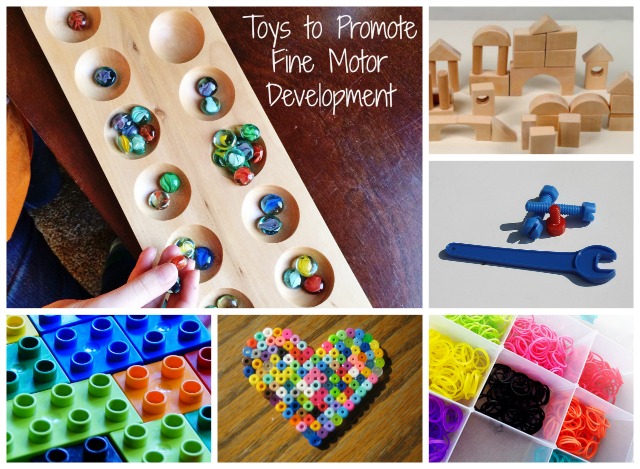
- Mancala
- Traditional wooden blocks
- Legos – opt for loose blocks and not themed sets
- Guidecraft construction blocks
- Tool sets
- Pegboards – buy one from Etsy, Amazon or DIY
- Geoboards – buy from Etsy, Amazon or DIY
- Build & paint car kits
- Rainbow Loom
- Perler beads
4. Make use of everyday objects
Sometimes the best toys are not even meant to be toys! Consider having these available for play:
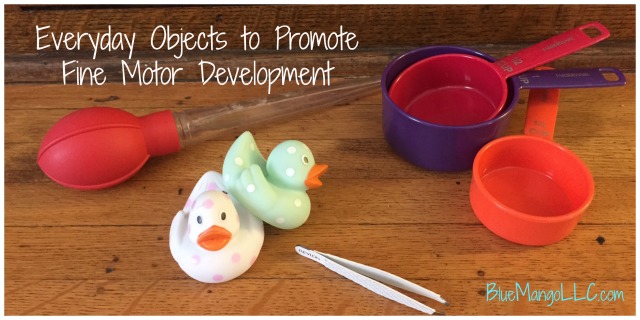
- cardboard boxes – need ideas? follow my Pinterest board!
- tweezers
- chopsticks
- turkey basters
- squeezable bath toys
- scoops & measuring cups
- medicine droppers
- squirt bottles
- chip clips
- buttons, dried beans & dried rice
Christie Kiley often tells parents of children receiving OT services that there are lots of ways to provide the same type of therapeutic practice in their own homes:
Some examples include pinching toothpicks and dropping them into an empty spice container, squeezing chip clips onto the edge of a box, playing with a squirt bottle, and pushing pipe cleaners into the holes of a colander.
5. Have great arts & crafts materials on hand
I always loved stocking up the art center in my classroom at school – often we called it the “Creation Station” because it was so much more than just drawing or painting.
Promote fine motor skills by encouraging kids to make art or create inventions by cutting & pasting, threading & beading, working with small objects and building with clay or cardboard.
Here are some great materials to have on hand at home or in the classroom.
Build

I probably spent most of my childhood constructing things (mostly houses) out of cardboard boxes. Not a surprise I studied architecture in undergrad. I also have a deep appreciation for the hand muscles involved in cutting corrugated cardboard with scissors.
- recycled cardboard boxes
- recycled plastic containers & bottles
- glue
- masking tape
Sculpt
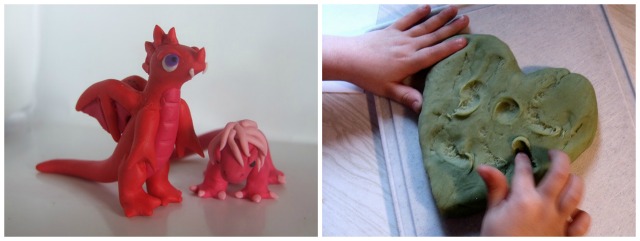
Some of my favorite ways to spice up play dough are to add tools like knives and plastic scissors. I also hide plastic jewels inside play dough to let kids find them as a quiet time or stress relieving activity.
Use any of these materials to help build letters or sight words in the classroom.
- clay
- play dough (make your own!)
- Wikki Stix
Sew & make jewelry
Don’t be fooled – boys love this too! In my class we always made “pattern bracelets” with beads and pipe cleaners as a math center. We also made necklaces with fruit loops (arrange by color in groups of 10s) for the 100th day of school.

Sewing can be just putting yarn through punched holes in construction paper to actually sewing real things. Don’t just make beaded necklaces but teach kids how to braid friendship bracelets.
- plastic needles (real ones for older kids!)
- thread, yarn, string
- wire
- pipe cleaners
- beads, noodles
Cut, paste & fasten
Don’t forget about traditional arts & crafts materials. These are always handy to have around.

- scissors
- hole puncher
- glue, glue sticks or paste (all use different muscles)
- scotch tape, colored masking tape
- paper with assorted thickness (tissue, construction, card stock)
- fabric squares
- brads (brass fasteners)
- stamps & ink
Also consider including small objects that really require the pincer grasp for kids to add to their art work:

- buttons
- pom poms
- jewels
- stickers
- toothpicks
Use your whole body
In addition, any activity done in a standing or prone position will also help with overall core and upper body strength. Use sidewalk chalk outside, have clipboard available for work on the floor and use easels for drawing and painting.
What will you implement today?
Although a lot has changed with children’s toys and play over the last few decades, the great news is that with a few small changes you can easily bring back fine motor development into your children’s day.
Make thoughtful toy purchases and take advantage of everyday fine motor activities such as buttoning a jacket or kneading pizza dough.
Just by understanding the importance of the hand muscles and pincer grasp, you will be able to evaluate toys and materials on your own and come up some great activities.
Want to share this information with parents and friends? Download the FREE printable PDF Tips to Improve Fine Motor Skills today by clicking here!
Please share your creative fine motor activities!
- Has this post inspired you to change anything at home? About the way you teach?
- What activities do your kids or students love?
- Have you found any strategies that work really well?
Start the discussion by leaving a comment!
Image credit: This post wouldn’t have been possible without all the gorgeous images. Many thanks to… Gerwin Sturm, Janet, Steven Depolo, lisaclarke, Daniela, Hsien-Hsien Lei, Gina Lee Kim, davidd, photographer pandora, Andrea R., Lars Ploughman, Matt Preston, Pearlmatic, Ville Oksanen, Travis Swan, Angie Six, Dana, Christine McIntosh, John Parrish, Shannon, Diana Robinson
